Optics
To fit the camera inside the projector lamphouse, it has to be pretty close to the film. That means a short focal length lens – the typical 50mm enlarger lens won’t work. On the other hand, the lens can’t be too close to the film, or it will run into the shutter and claw.
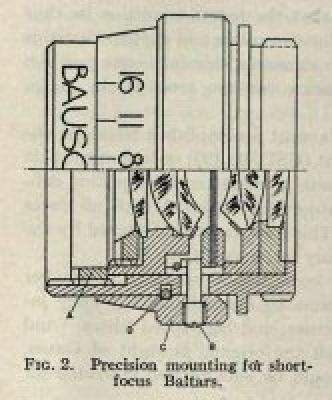 I happened to have an old lens of the ideal focal length. It’s a Bausch & Lomb Baltar 17.5mm f2.3. It was a state-of-the-art 16mm movie camera lens in 1946, and it’s design is excellent for this job. It has an adjustable aperture, and as is typical, it seems to give the best results at a mid range aperture of f4 or f5.6.
I happened to have an old lens of the ideal focal length. It’s a Bausch & Lomb Baltar 17.5mm f2.3. It was a state-of-the-art 16mm movie camera lens in 1946, and it’s design is excellent for this job. It has an adjustable aperture, and as is typical, it seems to give the best results at a mid range aperture of f4 or f5.6.
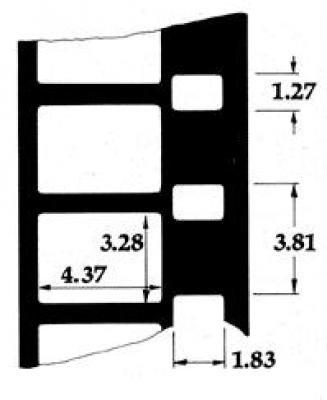 The 8mm film frame has a diagonal of about 5.5mm. The CCD in the camera has a diagonal of 4.5mm. So the magnification required is about 0.8x. At magnifications this close to 1, the distance from the film plane to the CCD focal plane is roughly 4x the lens focal length, or 70mm. This makes a very compact camera unit …
The 8mm film frame has a diagonal of about 5.5mm. The CCD in the camera has a diagonal of 4.5mm. So the magnification required is about 0.8x. At magnifications this close to 1, the distance from the film plane to the CCD focal plane is roughly 4x the lens focal length, or 70mm. This makes a very compact camera unit …
… that fits nicely in the lamphouse of the projector …
The lens and camera are mounted on a brass plate that slides over two standoff posts attached to the projector lamp mounting plate. Springs over the posts press the camera plate against two thumbscrews mounted above and below the camera, in a bridge plate fixed to the ends of the posts. Turning these screws together adjusts focus. Individually, they tilt the camera plate slightly, aiming the camera and lens up or down to easily align the camera field with the film frame vertically. A third thumbscrew in a block on the back of the bridge plate moves a standoff post attached to the camera plate to tilt it from side to side and thus adjust horizontal framing.
The lens is mounted on a focusing helicoid, but at magnifications near 1, moving the lens mostly changes magnification, without changing focus very much. So I adjust the mag first, by turning the lens mount, then adjust focus and framing with the camera screws. Setup is quick and easy, and it’s much simpler and easier to construct than X/Y/Z translation mechanisms.
There are five springs altogether – the two post springs, a spring that holds the camera plate tilt post against the horizontal tilt screw, and two more that force the plate sideways against the main posts…
The springs, screws and posts perfectly constrain the position of the plate, so it cannot shift if the projector is bumped.
I captured the image below just to confirm that the lens is sharp enough to not limit the resolution of the movie captures. Lacking a micro resolution target, I used a PROM chip, 3.5mm square, which provides plenty of fine lines. It’s captured with the webcam and lens at the same magnification I need for the telecine. The blue and orange colored bands in the middle of the chip are the result of the fine pattern aliasing on the color filter array of the CCD. This is the sign that the lens resolution is more than adequate. Grainy 8mm film doesn’t have such fine line patterns, so we won’t see aliasing in movie frames.
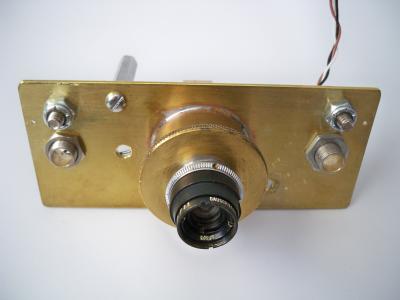
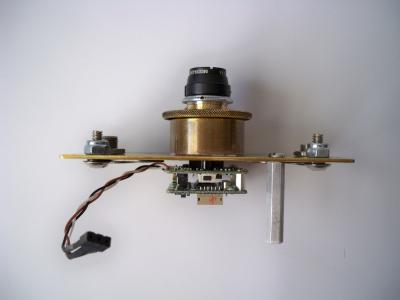
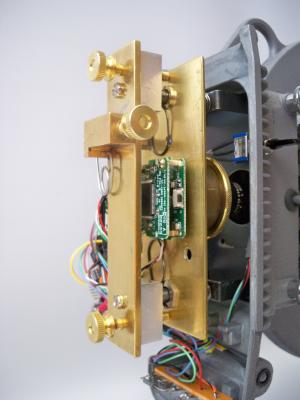
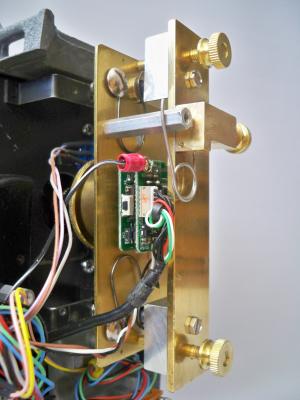
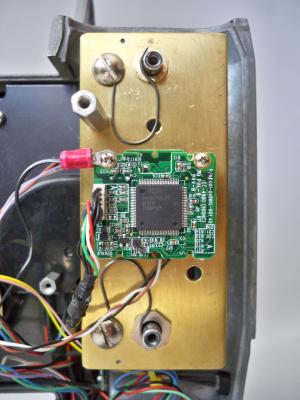
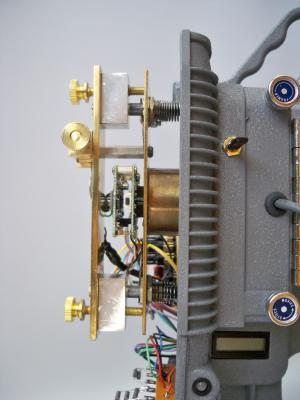
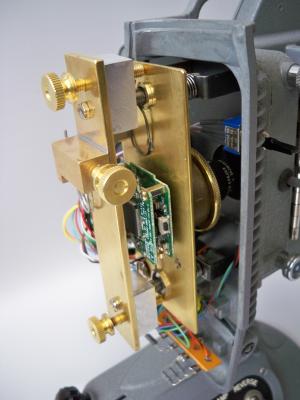
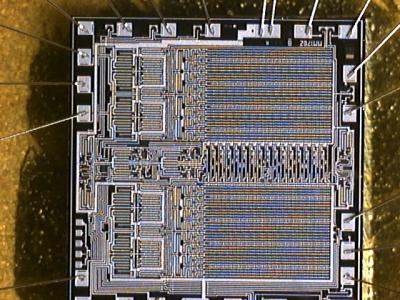

How do you calculate distance between CCD and lens? I have three lenses from old 8 mm camera 9mm f:1.9, 13mm f:1.9, 25mm f:1.9 I use MiDAS Lens Calculator to get object distance. I get about three times than focus (i.e. 9mm > 25) but I can not find how to calculate distance between CCD and lens. Please advice me.
Thanks:
Steve
Comment by Steve Varadi — April 6, 2010 @ 12:09 pm
m = magnification
f = focal length (17.5mm for me)
u = film distance
v = ccd distance
hu = film diagonal (5.5mm for me)
hv = ccd diagonal (4.5mm for me)
1/u + 1/v = 1/f
m = hv/hu = v/u = (v-f)/f = f/(u-f)
v = mu = (m+1)f
u = v/m = ((1/m)+1)f
The image size is proportional to the distance, so the larger of the CCD or film frame is farther from the lens.
Remember that the measurements are to the optical center of the lens, not the exposed element. So v and u are measured from the same center point on the lens, but you may not be able to tell exactly where that is for a multi-element lens. To find out, focus the lens on a very distant object. The center point is one focal length from the image plane.
For my CCD and 8mm frame and 17.5 mm lens…
m = hv/hu = 4.5/5.5 = 0.82
v = (m+1)f = (1 + 0.82) * 17.5 = 31.85mm
u = ((1/m)+1)f = ((1/0.82) + 1) * 17.5 = 38.84mm
And to double check…
1/31.85 + 1/38.84 = 1/17.5
Total distance from CCD to film is 31.9 + 38.8 = 70.7mm
Comment by jimmymc — April 6, 2010 @ 1:17 pm
Thank you very much for the math lesson:)) I hope I will able do it according this formula. I will let you know my progress. BTW. I convert an old Eumig Mark S 810D projector because I have both N8 and S8 films.
Thanks again:
Steve
Comment by Steve Varadi — April 7, 2010 @ 1:26 am